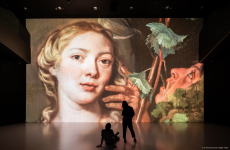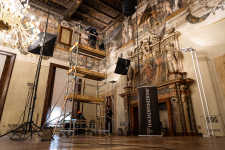The Museum of the Twentieth Century in Milan and Haltadefinizione have collaborated on the ultra-high definition digital acquisition of a new selection of works held in the museum. This follows the ultra-high definition digitization of The Fourth Estate by Pellizza da Volpedo (on view here) which led to the discovery of some of its amazing details.
The works include three by Umberto Boccioni, Elasticity (1912), “Corpo umano (Dinamismo)” (Human form (Dynamism) of 1913, and “Dinamismo di un corpo umano” (Dynamism of a human form, also of 1913, as well as The Portrait of Paul Guillaume by Amedeo Modigliani (1916), Wald Bau by Paul Klee (1919) and Composition by Vasilij Kandinskij (1916).
The Museum of the Twentieth Century decided to use ultra-high definition digital capture as a method to study the conservation status of these selected works, which are displayed in the museum’s recently rennovated space. The digital capture technology was developed by Haltadefinizione with its partner company Memooria.
“The digital acquisition of works of art in ultra-high definition Gigapixel format uses a process that is totally non-invasive which never comes in contact with the work,” declares Luca Ponzio, founder of Haltadefinizione. “It allows for the collection of information useful for monitoring. That same data set can also contribute to enhanced use and valorization of the works themselves.”
These masterworks will soon be available to the public on the websites of both the Museum of the Twentieth Century and Haltadefinizione. The digital viewer will reveal secret details of the Futurist painters’ use of color. This immersive experience goes along with the emotional experience of viewing the works in their museum rooms.
Characteristics of the ultra-high definition Gigapixel format
The selected works were captured digitally using a new photographic technique which allows the creation of a very large format ultra-high resolution digital image (at a minimum of 800 ppi or pixels per inch), which is extremely clear and accurate. This high level of precision allows for faithful reproduction of the proportions and colors of a work of art, and also for extremely close observation of its smallest details.
The digital image is also an important tool for monitoring the conservation status of works of art. For example, details like small areas of layer separation, cracks or other patterns of decay in the picture surface, may have been invisible before, or not easily identifiable to the naked eye. Now these can all be documented and studied with a deep digital inspection of the surface of any work of art. An ultra-high definition Gigapixel image is thus an indispensable tool for conservators. The first digital capture makes a baseline and later scans can be compared to it, to reveal changes and deteriorations in the surface that may occur over time.
How an ultra-high definition Gigapixel image is made
A Gigapixel image is the result of thousands of individual high-resolution snapshots of portions of the work, which are later stitched together with specially designed software, that allows for the display of a the whole work as a single image. The number of snapshots depends on the size of the work being captured. It all takes place with processes that guarantee the absolute security of the original work.
The shot angles and choice of cameras and other instruments are all determined on site, based on the work and its environment, in order to avoid ever moving or touching it.
The photographic capture system is calibrated with specific targets to produce the most accurate focus, color reproduction and a minimum of image noise. The lighting system uses UV-blocking filters to keep potentially damaging UV light off the work.
All of the equipment that Haltadefinizione uses in its digital photographic capture technology is designed to meet the strict requirements for the protection of works of art published by the Istituto Superiore per il Restauro (ICR), the Higher Institute for Restoration.



